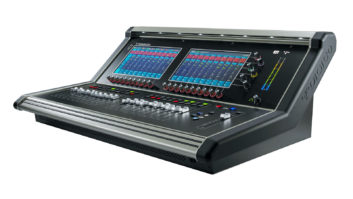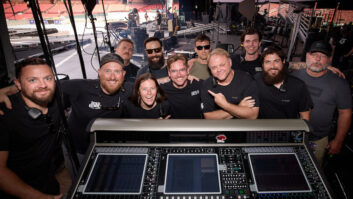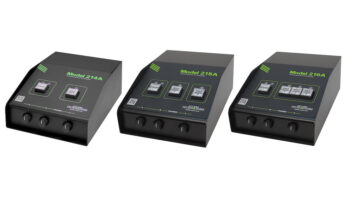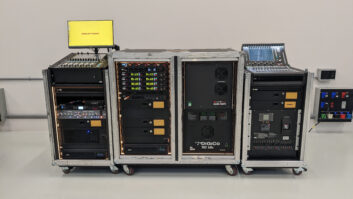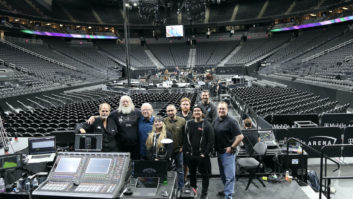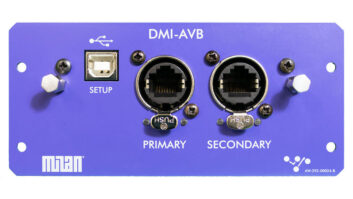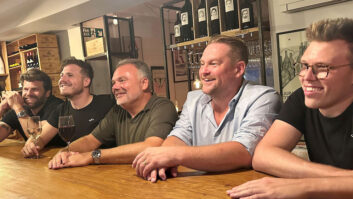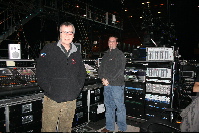
Celebrating his 25-year musical career, George Michael’s 25 Live tour featured three DiGiCo consoles: a D5 Live for FOH, another for the singer’s monitors and a D5T for band monitors.
Andy “Baggy” Robinson (pictured, with John Roden) has worked with Michael for the past three years. He is the tour’s head of sound and Michael’s monitor engineer. “Early on it was obvious this show was going to need a digital desk solution,” he says. “With 15 in the band, including six backing vocals, plus the lead vocal, who has very exacting monitoring requirements and needs large amounts of time devoted to him, it swiftly became apparent that monitoring would be a job for two people.
“We brought John [Roden] in to do band monitoring and discussed the pros and cons of the potential digital solutions,” Robinson continues. “It was quickly obvious that DiGiCo was the way forward. We could share inputs, have a large number of channels, and all the outboard we would ever need could be connected. When [FOH engineer] Gary [Bradshaw] came onboard, he decided to join us, although it would have been easy for him to take any desk solution, as FOH and monitors didn’t share stage racks.”
“A lot of our parameters were already in place before we were brought onboard, as the art department had already made several crucial decisions, which dictated the way we had to approach the gig,” Roden adds. “[The console choice was] probably the only system we could have put together to do all the things we were doing. All three of us had used DiGiCo consoles before and were comfortable with the operating surface. Plus, DiGiCo are pretty cool dudes, and we knew their support would be superb, as always.”
A key requirement for the show was to have as many channels as possible. The flexibility of the DiGiCo D5 design meant that all the onboard console effects could be turned off to gain more channels—all effects being run from outboard—and allowed Robinson to design a complex system which linked all three consoles.
“We used two stage racks each for FOH and monitors, giving a total of a possible 112 inputs, of which we were using over 100 for the show,” he says. “Each monitor board then had two local racks for the outboard connections needed. This meant that, ultimately, we were running 160 channels each.
“FOH also had a local rack and a third stage rack, with all racks on an Optocore loop,” Robinson continues. “The channels of each second local rack and the third FOH stage rack joined the desks together so that mixes and direct outs could be shared between the desks, all within the digital domain. Where possible, we kept everything digital, including the outboard.”
The tour’s main loudspeaker system comprised d&b J8s and J12s each side, with floor-stacked subs. Side hangs comprised Martin Audio W8LCs and W8LMs, collectively giving almost 270-degree coverage and allowing for the maximum number of seats to be sold in each venue—a factor also aided by the small footprint of the DiGiCo consoles.
Because Bradshaw had to disable the D5’s processor channels and effects, a TC 6000 was used for reverb, thickening and double tracking of Michael’s lead vocal; the same unit was also used for drum reverbs. A range of other delays, reverbs and dynamic effects were used at FOH, all linked via MIDI to effect program changes as Bradshaw loaded the snapshot for each song onto the D5, which also recalled all faders, mutes and EQs. “I also used the notes page, which is very handy to write cues on, as they changed song-by-song with the snapshots,” he says. “During rehearsals, I was able to record everything on Digital Performer via the D5’s copy MADI link. I could then play them back into the desk to fine tune the mixes.
“We also recorded all the UK shows for archive purposes, again using the copy MADI feature,” Bradshaw continues. “Two separate Metacorder recorders, backing up on to hard drives with a Soundtracs DS-00 used for gain tracking to the recording to ensure that any changes made to the mic preamp onstage did not alter the levels on recording.”
During the show, Bradshaw also used the console to send six analog feeds—lead vocal, backing vocals, bass, submixed guitars, percussion and keyboards—to the video crew. These signals were used to generate interactive images on the main video screen, meaning that the audio would affect images on the screen, which would move or change in time with the music. Bradshaw also used the D5’s snapshot feature to control these feeds so that in one song, the percussion trigger could be the kick drum while in another it could be the congas and so on.
Down by the stage, things were just as interesting at the monitor consoles. Stage monitoring was a combination of IEMs and d&b wedges/sidefills, with the Robinson-manned D5 exclusively used for Michael’s monitoring needs. “I was running in 160-channel mode to be able to bring every input and effect return on to a fader,” Robinson says. “It’s a complex show from the monitoring perspective, so I used snapshots for every song. I had to! I’m running George’s IEM chain from his vocal in analog, but I make up the effects returns and band mix from the D5. All digital boards have a latency, and George’s incredible ears heard this, so DiGiCo’s marvelous help came into play once again, and they made my main fader analog so I could snapshot the level of this vocal, even though it is analog.”
“I had 15 people onstage, all with multiple inputs and all with very individual monitoring requirements, so the snapshots feature was essential for me, as well,” says Roden, who had also done monitors on Wham’s The Big Tour two decades ago. “All the muting and subtle mix changes were taken care of with the push of a button. And the cue/snapshot notes feature was very important.”
The entire 48-date tour was completely sold out, and, technically, it proceeded extremely smoothly, proof that the time taken to design such a complex system was well worth it. “We did make a few minor changes to the system, but it worked extremely well,” Robinson says. “I have learned over the years that for a show this size, redundancy at the start is key. It was that sort of production—I wouldn’t have been surprised if we’d added a choir one day!”
“The DiGiCo system did everything we asked it to do,” Bradshaw adds. “Production are happy because of the very small footprint at FOH, and I’m happy with a desk that sounds as good as anything I’ve used in the past. I can operate it with what I think is the best balance between recall and manual operation, all in a very neat package.”
For more information, visit www.digico.org and www.georgemichael.com. Get your touring update at mixonline.com/livesound/tours.

